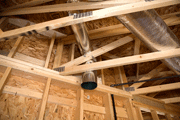Key Principles Of Ductwork Design
Efficient ductwork design is a crucial component for maximizing energy savings, heating/cooling system efficiency, and enhancing your home comfort. For new construction or retrofits, it’s an absolute necessity to design your duct system using the following principles of ductwork design:
- Location: Utilize conditioned areas for installing ducts wherever possible. This reduces airflow temperature loss/gain in unconditioned areas, such as the attic or crawlspace. Heat conduction through duct walls increases the load on heating/cooling equipment, reduces home comfort, and increases utility bills. Avoid too many turns and sharp angles when installing ducts. Ductwork should take the shortest, straightest route possible from the air handler to the registers.
- Sizing: An HVAC professional should take into account several factors when sizing ductwork. Some of these include your home’s square footage, the floor plan, the size and number of windows, your home’s orientation to the sun, the number of floors, construction materials, and the size of your heating/cooling system. Ducts may need to taper to maintain velocity as they extend to distant air-supply registers.
- Installation and sealing: Correct installation and sealing ensures energy efficiency, minimized noise (e.g. bangs, booms, and rattling), durability, indoor air quality, and balanced heating and cooling throughout your home. All duct connections, including registers and grilles, should be soundly sealed using mastic, fiberglass mesh, aluminum tape and/or joint collars. Ducts require a minimum of one-inch clearance from all building structures such as pipes, walls and studs. Return grilles should be installed on each level of living space. Air-supply registers should be installed in every room when practical.
- Insulation: If installing ducts in unconditioned areas is unavoidable, insulation should be applied to minimize heat conduction (wasted energy). Round ducts may be wrapped with insulation rolls and taped. Square ducts may use rolls or rigid fiberglass board.
For more information on the key principles of ductwork design, and more ways to save energy in your South Florida home, please contact us at NisAir Air Conditioning & Heating.

